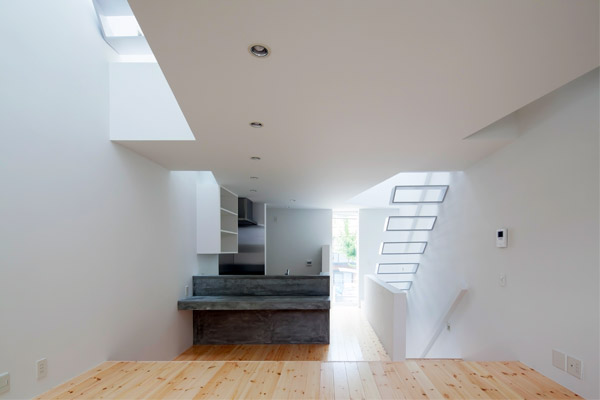In a small Osaka district where houses, factories and buildings coexist without real harmony, architect Kenji Ido of Ido, Kenji Architectural Studio, discovered a way to invite the light. By Thomas Tran.

February 24th, 2014
In a style reminiscent of Japanese origami, House in Tamatsu and House F are both Ido’s answers to two separate briefs desperate for some natural lighting.
“I start with probing the architectural language currently considered to be natural” says Ido, “such as a wall or window, and explore the meaning behind these elements for every project”.
The three-storey house in Tamatsu features a unique skewed upper storey that strategically elevates its position over the prying eye of neighbouring buildings.
“The client requested the family room to be as large as possible without pillars or road-bearing walls, and that natural light come into the house,” explains Ido.
By rotating the second floor 14 degrees and capitalising on the interstitial voids created by the shift, ample sunlight trickles down into the family room from the top storey.
The main bedroom and wet rooms are positioned on ground level, with hollow white boxes for stairs guiding up into the family room on the first storey. Ido carefully considered the client’s lifestyle and family of four in his approach to the brief.
The second storey features the children’s room, which leads up onto the open roof terrace.
Likewise, House F offers a visually narrow yet considered design with a striking timber façade.
Ido planned the three-storey home for a couple, with key focus on the minimalistic front driveway and small garden at the rear.
“The client requested a garden in the south side of the site, and decided to make [the] building three storeys to secure required rooms,” mentions Ido.
The profusion of wide windows, coupled with crisp white walls, provide the necessary illusion of brightness and openness in an-already restrictive space.
A traditional Japanese room replaces the bedroom on ground level and offers a sleeping area that extends out into the garden.
Pine is extensively utilised throughout the house, from flooring to doors to bookshelves. “[It’s] aimed as a quiet, soft space with the wood and the paint-finished walls,” adds Ido.
With a total floor area of just 95 and 117 sqm respectively, House in Tamatsu and House F both succeed in design under Ido’s tenacious yet practical vision.
Ido, Kenji Architectural Studio
kenjiido.com
INDESIGN is on instagram
Follow @indesignlive
A searchable and comprehensive guide for specifying leading products and their suppliers
Keep up to date with the latest and greatest from our industry BFF's!
The new range features slabs with warm, earthy palettes that lend a sense of organic luxury to every space.

A longstanding partnership turns a historic city into a hub for emerging talent

Welcomed to the Australian design scene in 2024, Kokuyo is set to redefine collaboration, bringing its unique blend of colour and function to individuals and corporations, designed to be used Any Way!

How can design empower the individual in a workplace transforming from a place to an activity? Here, Design Director Joel Sampson reveals how prioritising human needs – including agency, privacy, pause and connection – and leveraging responsive spatial solutions like the Herman Miller Bay Work Pod is key to crafting engaging and radically inclusive hybrid environments.
Paul Townsin has won the Barrisol Lumiere Design Competition for his ‘Halo’ pendant light design.
The much-anticipated Changi Airport’s new Terminal 3 was officially launched this July in Singapore, after a seven-year development project led by Australian firm, Woodhead.
The internet never sleeps! Here's the stuff you might have missed

At Saltbox in Sydney, this year’s INDE winners – including a Best of the Best from Asia – were announced at an extravagant, fun Gala awards night.

The 2025 INDE.Awards winners were celebrated at the annual Gala in Sydney on 31st July.